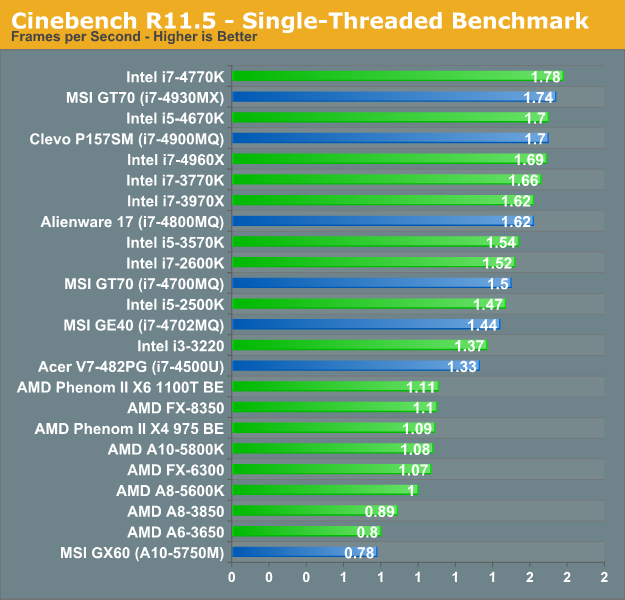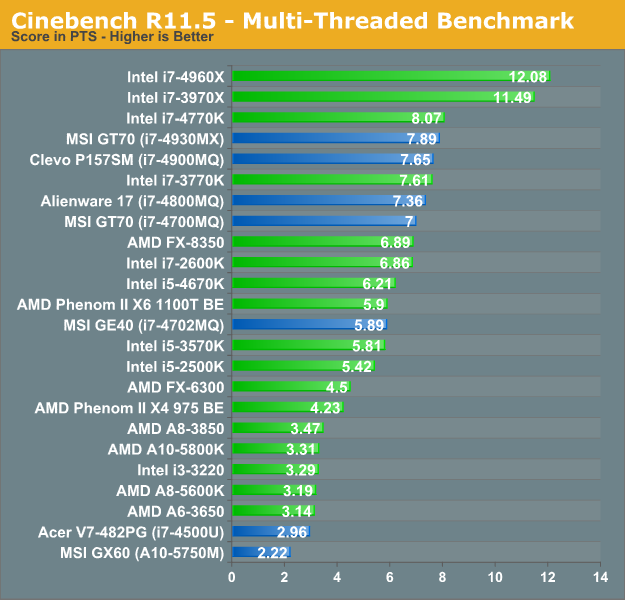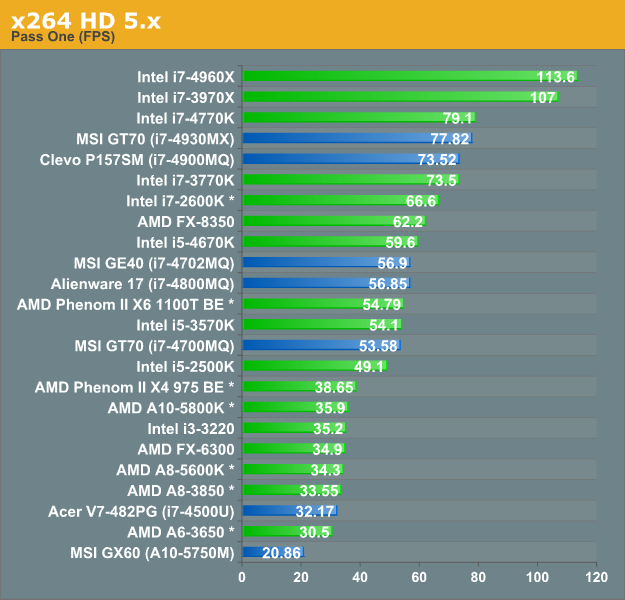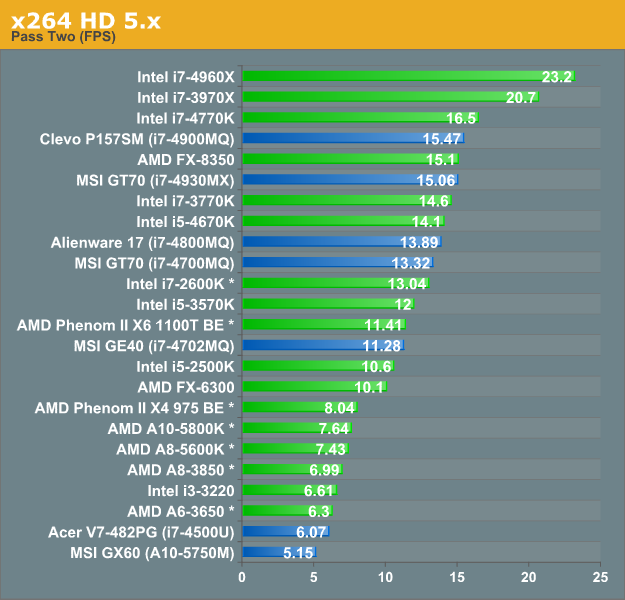Analyzing the Price of Mobility: Desktops vs. Laptops
by Jarred Walton on September 7, 2013 5:55 PM ESTCPU/General Performance Discussion
With that out of the way, let’s focus on the remaining two areas, starting with CPU performance. I’ve grabbed several generations of desktop CPUs from both AMD (K10.5, Llano, Trinity, Bulldozer, and Piledriver – we don’t currently have Richland results, but they’re generally 5-10% higher than Trinity) and Intel (Sandy Bridge, Sandy Bride-E, Ivy Bridge, Ivy Bridge-E, and Haswell) and combined those results with the latest mobile CPUs (Haswell quad-core, Haswell ULT, and Richland). We’ve got two benchmarks that are common to our CPU and laptop we’re going to look at: Cinebench 11.5 (single- and multi-threaded) and x264 HD 5.x video encoding (first and second pass).
Unfortunately, we don’t have results for all of the desktop CPUs in x264 HD 5.x, though you can get an idea of where they should fall by looking at the x264 HD 3.x results. We’ve gone ahead and used the x264 3.x scaling for desktop CPUs where we don’t have 5.x results, and marked those results with an asterisk (*) in the following graphs. The first pass tends to be about 2x as fast with x264 HD 3.x, unless you have four cores with Hyper-Threading in which case scaling is closer to 1.5x (and 6-cores results in scaling of around 1.08x). The scaling in the second pass is much more uniform, with 3.x being around 2.75x as fast as 5.x. Since we’re already comparing apples and oranges in a sense (desktop and laptops, with different motherboard, RAM, etc.) we’re really just interested in an estimate of performance. Do not take the following charts as 100% definitive, but rather as a baseline comparison.




It used to be that if you wanted top CPU performance, a desktop system was absolutely required. These days, for lightly-threaded workloads the gap has narrowed substantially: a moderate i7-4700MQ Intel Haswell processor will get you around 85% of the performance of the desktop i7-4770K, and the i7-4930MX will get you 98% of the single-threaded performance. Even the i7-4500U Ultrabook is able to deliver 75% of the 4770K performance. Move to heavily threaded workloads and the gap grows (particularly if we included the hex-core processors), but the 4700MQ and 4930MX are still 81-87%/91-98% of the 4770K performance – it’s the dual-core mobile CPUs that really take a hit, with the i7-4500U delivering roughly one third (37-41%) the performance of the 4770K. Of course, if you’re not doing CPU intensive tasks like video encoding, the single-threaded performance will be the more pertinent result.
The AMD side of the equation isn’t nearly so rosy, at least if you want performance anywhere near that of a top-end desktop. Llano, Trinity, and Richland have been far more focused on reducing power use and increasing integrated graphics performance than on boosting CPU performance. The result is that in single-threaded performance, the fastest mobile Richland APU is less than half the performance of the 4770K, and in the multi-threaded tests it’s 26-31% of the 4770K performance. Comparing mobile Richland to desktop AMD parts doesn’t really help much either: in the single-threaded Cinebench result, it basically matches the Llano A6-3650 and is 12% slower than the A8-3850, while it trails most of the other AMD CPUs/APUs by nearly 30%. Move to multi-threaded workloads and it’s only able to deliver 30-60% of the more powerful AMD desktop APUs (and 60-80% of the desktop Llano APUs). Richland is still “fast enough”, but it’s definitely a value proposition as opposed to a performance option – the iGPU of Richland may be faster than HD 4000/4400/4600, but dGPUs like the GT 730M are still roughly twice as fast and available for not much more money. But we’re skipping ahead….
Summarizing the general performance of our mobile platforms, we’re able to come pretty close to the performance of desktop systems, and while there’s still a price premium in effect it’s definitely getting smaller than in the past. The least expensive laptop/notebook I can find right now with a quad-core Haswell CPU is the HP Envy 15t-j000, which you can currently get for $700 after the $100 instant discount. That will get you 8GB RAM, 1TB HDD, and Windows 8, but not too much else. Adding a 1080p LCD ($50), GT 740M ($70), and a backlit keyboard ($30) brings the total to $850. That’s roughly the same performance as a Sandy Bridge i7-2600K, and slightly faster than the Haswell i5-4670K. You can get a pre-built desktop from Newegg for $700 (which adds in an HD 7750 GPU), while a DIY system with similar specs to the laptop (e.g. no dGPU) will set you back $672 (see table below) – not including a mouse, keyboard, display, or speakers.
| Mainstream Desktop PC | ||
| Component | Description | Price |
| CPU | Intel Core i5-4670 (Quad-core, 3.4-3.8GHz, 6MB L3, 22nm, 84W) | $200 |
| Motherboard | ASRock Z87 Pro3 LGA-1150 | $115 |
| Memory | 2x4GB DDR3-1600 CL9 1.5V RAM | $65 |
| Storage | Seagate 1TB 7200RPM HDD | $70 |
| Optical Drive | SATA DVDRW (Lite-On) | $18 |
| Case | Antec Three Hundred | $60 |
| Power Supply | Seasonic 350W 80 Plus Bronze | $44 |
| Operating System | Windows 8 64-bit (OEM) | $100 |
| Total | $672 | |
In other words, if all you want is a computer for moderate needs, it’s not hard to see why laptops are displacing desktops for many people. In this case we’re able to get the same level of performance for potentially less money (depending on whether or not you need to buy an LCD, keyboard, and mouse). Desktops are still going to be far more upgradeable, and you can take a “basic use” desktop like the one above and upgrade it with a high-end graphics card for $300 to get a potent gaming PC. Adding more memory, more storage, upgrading the motherboard and CPU, etc. are all things that you can do with a desktop, whereas with laptops typically only the RAM and storage can be upgraded/replaced and if anything else breaks you’ll have to send it in for repairs (or buy a new laptop).p
We can go down to lower price points of course – there are desktop PCs with moderate hardware starting at just over $300, and they’re still more upgradable than laptops, but similar performance laptops can be had for about the same price, especially if you look at some of the previous generation hardware. It’s mostly a question of how much performance you want/need, and whether you’re interested in the potential to upgrade components down the road. If you don’t have any plans of adding more RAM, storage, or a GPU the case for laptops is stronger now than ever. And let’s not forget that most laptops have an idle power draw south of 20W, compared to 40-60W for a typical desktop (and that’s not including the display or speakers on the desktop), so the energy factor also favors laptops.










110 Comments
View All Comments
JarredWalton - Saturday, September 7, 2013 - link
Yeah, apparently anything tagged AMD gets the branding. Ah well... not my problem! Hahahateiglin - Saturday, September 7, 2013 - link
I might be torpedoing this workaround by mentioning it, but the print view uses the standard color scheme (and is way better in all other ways as well).b3nzint - Saturday, September 7, 2013 - link
"it’s far better to have a decent gaming desktop and then to spend another $500-$1000 on a good laptop for when you need to go mobile"yes right.
pc / laptop, its like comparing boys or girls. they r on diff "world". case closed.
Roland00Address - Saturday, September 7, 2013 - link
CPU performance does not scale well with power consumption. Architectures are design to hit a desired cpu clock speed and anything above that desired clock speed causes a massive increase of power consumption. The 2nd and 3rd generation core series have massive increase in power consumption to get higher performance at 3 ghz and massively increase in power consumption past 3.5 ghz. I am assuming this holds true to haswell as well. (This is probably why intel keeps the laptop cpu range in <3 ghz range using boost to go past 3.0 and the same logic with desktop cpus of 3.5 ghz using boost to get 3.5 ghz.)There is a great anandtech forum post i7-3770K vs. i7-2600K: Temperature, Voltage, GHz and Power-Consumption Analysis by Idontcare that demostrates this very nicely in graph format.
You can't scale cpu usage very well by being more parallel for most software can't be made parallel past 4 cores very well (video rendering being an exception.) Thus the only way to increase cpu performance is better architecture with more transistors, or higher clock speed.
Because of this you can get very similar cpu performance in laptops vs desktops.
--------
Graphics on the other hand scales very well increased parallelization. The only limiting factors with graphics is the cost of the silicon, and the thermal constraints. Thus you will always get massively better gpu performance in desktop vs laptops for you are not limited by thermal constraints. It is okay to run that gpu with a desktop at 300 watts while the desired power consumption for a laptop card is either less than 50 watts or 50 to 100 watts for a desktop replacement.
This will probably never change with time.
nerd1 - Saturday, September 7, 2013 - link
The whole point here is that nowadays most games run just fine with 50W GPU at 1080p with pretty much everything turned on, as they are supposed to run on 8-year-old consoles as well. So for most people mainstream laptops are approaching the point that they are 'good enough' for gaming.Roland00Address - Saturday, September 7, 2013 - link
Well that was not communicated very well then considering the choices made for testing (hint almost all of then are in desktop replacement where the gpu by itself takes more than 50W of energy)750m is about 38 W tdp
760m is about 55 W tdp
765m is about 75 W tdp
770m is about 75 W tdp
780m is about 122 W tdp
Of the games tested the 765m is only above 30 fps in starcraft ii and skyrim (at 1080p) all the other games we need to turn down the settings to get above 30 fps. If you chosen instead a gtx 760 ($250 dollar desktop card) you can get those same games at 60fps in all the games except metro 2033. Tomb Raider would be close for it would be in the mid 50 fps.
You can get an enjoyable "ultimate" performance out of a laptop if you go full desktop replacement such as a alienware 17", clevo, msi, asus rog, etc but as the chart shows you would get much better gpu performance out of a desktop. Remember these laptops would be a desktop replacement and thus weigh over 7 lbs and have a gpu that is using 75+ watt tdp.
You can get "great" performance out of a geforce 760m or 765m but it won't be "ultimate" either the resolution has to go down or the settings (medium or high instead of ultra) has to go down to get current games at a 30+ fps.
--------------------
In a few years (a die shrink, maybe two) you can get a future gpu to run at 50w and do all these current games on 1080p with these settings at 60fps. Then again during that same time we will get xbox 360 and ps4 console ports for any new game thus you will be needing once again a desktop replacement to get similar performance to the console. You will not be getting a ps4 gaming performance in your ultrabook in the next 3 years. In your larger laptops it will be another matter.
--------------------
So I repeat my larger point, you can get similar cpu performance easily in a laptop. You can't get similar gpu performance in a laptop vs desktop for with a desktop you are not limited by thermals while with laptops you are trying to keep total thermals (cpu+gpu+screen+everything else) under 65w for normal laptops/ultrabooks, about 100w for things like the razer blade 14" / 15" retina display, 125w to 150w for beginner desktop replacements such as the gtx765m (msi dragon 17") and 200w for alienware 17" with a single gtx780m.
nerd1 - Saturday, September 7, 2013 - link
There is no ceiling for *ultimate* performance, you can spend $3K for tri-titan setup, add liquid cooling to OC them, another a few K for (multiple) 4K displays and so on. 60fps may not be enough for some *ultimate* gamers. I've been playing fps myself for years, and old quake 2 required 100+fps framerate for some techniques (like acceleration jump)What we're discussing now is *good enough* performance, which I can be achieved by 760M or 765M. 765M is reasonably cheap, can be fit into either 13 inch laptop or 18mm thin laptop, and can run most game. I've been using similarly powerful 6990M GPU for a while.
MDX - Sunday, September 8, 2013 - link
Well saidSaint04 - Saturday, September 7, 2013 - link
To the author,I just wanted to say that I had noticed the comment under the Alienware 17 review about the need for contrasting mobile GPUs from Desktop GPUs. You did just that and in a timely fashion too! I just wanted to say thank you for being responsive to your readers.
jjj - Saturday, September 7, 2013 - link
Ok so no OC in CPU perf,you include a 250$ GPU just to push the price way up and you fully miss the real issue.The question you have to ask is why? Why are we here?
We pay 300$ for a small die and a large part of it is a GPU we don't use or need.
We can't touch a 6 core CPU at 250mm2 ,it costs too much. not so long ago Intel would have had to sell it at 300$ ,hell they would most likely have 8 core dies with less cache if there was any damn competition.
Things are not getting better in laptop ,they are just getting much much worse in desktop.and greed is killing the only PC segment that can be exciting. For short term gains Intel is killing the long term.
And even in laptop they are pushing ultrabooks to try to reset performance to a lower level and shorten the refresh cycle while pushing prices up.
All they'll achieve with this is speed up the transition away from Wintel and allow ARM to catch up in perf faster. They couldn't do worse than this if they would hire Elop as CEO.
Why don't you compare die size (excluding GPU) and price over the last decade in desktop instead of doing this article.